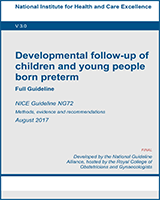NCBI Bookshelf. A service of the National Library of Medicine, National Institutes of Health.
This guideline focuses on the specialist developmental support and surveillance needed for the early identification of developmental problems and disorders in children born preterm.
The proportion of babies born preterm in the UK, defined as birth before 37 weeks’ gestation, has remained steady for several years at 7.4%. In 2014 this amounted to 48,985 from a total of 656,957 live births, of which 2438 (5% of preterm births and 0.4% of all births) were before 28 weeks' gestation.
Preterm birth is associated with an increased risk of developmental problems and disorders. These include developmental challenges, physical, sensory, cognitive and learning disorders, and emotional and behavioural problems. These may extend into adolescence and, in some cases, be lifelong. In particular, the risk and prevalence of impairments that affect educational attainment rise sharply in children born before 28 weeks' gestation. Although most major disorders are detectable in the first 2 years of life, several developmental disorders and problems, particularly those that have an impact on the child's ability to participate and on their educational attainment, may not be apparent until they are older.
Identifying developmental problems and disorders in all children (born preterm or at term in England) is currently through the Healthy Child Programme, which incorporates nationally approved population screening programmes recommended by Public Health England. This includes a review at 2 years to 2 1/2 years of age which includes an assessment of social, emotional, behavioural and language development.
This guideline aims to improve the identification of developmental problems and disorders in children born preterm, alert health professionals to risk factors that may increase the likelihood of these problems, define those preterm babies who are eligible for enhanced surveillance and support, and set standards for the delivery of enhanced surveillance and support. This is expected to improve outcomes for these children by reducing variation in follow-up and enabling benchmarking of neonatal care.
Contents
- Introduction
- 1. Guideline summary
- 2. Development of the guideline
- 3. Guideline development methodology
- 4. Risk and prevalence of developmental problems and disorders
- 5. Information, support and developmental surveillance
- References
- Glossary of terms
- Acronyms and abbreviations
- Appendices A - J. Appendices
- Appendix A. Scope
- Appendix B. Stakeholders
- Appendix C. Declarations of interest
- Appendix D. Review protocols
- Appendix E. Search strategies
- Appendix F. PRISMA flow charts
- Appendix G. Excluded studies
- Appendix H. Health economic analysis on identification of problems and disorders
- Appendix I. Resource impact analysis of delivery of enhanced support and surveillance
- Appendix J. Forest plots and receiver operating curves
- Appendix K and L. Evidence tables and supplementary tables - developmental follow-up of preterm babies
V 3.0
Developed by the National Guideline Alliance, hosted by the Royal College of Obstetricians and Gynaecologists
Disclaimer: Healthcare professionals are expected to take NICE clinical guidelines fully into account when exercising their clinical judgement. However, the guidance does not override the responsibility of healthcare professionals to make decisions appropriate to the circumstances of each patient, in consultation with the patient and/or their guardian or carer.
- NLM CatalogRelated NLM Catalog Entries
- Review Towards reducing variations in infant mortality and morbidity: a population-based approach[ 2016]Review Towards reducing variations in infant mortality and morbidity: a population-based approachField D, Boyle E, Draper E, Evans A, Johnson S, Khan K, Manktelow B, Marlow N, Petrou S, Pritchard C, et al. 2016 Mar
- Association Between Moderate and Late Preterm Birth and Neurodevelopment and Social-Emotional Development at Age 2 Years.[JAMA Pediatr. 2017]Association Between Moderate and Late Preterm Birth and Neurodevelopment and Social-Emotional Development at Age 2 Years.Cheong JL, Doyle LW, Burnett AC, Lee KJ, Walsh JM, Potter CR, Treyvaud K, Thompson DK, Olsen JE, Anderson PJ, et al. JAMA Pediatr. 2017 Apr 3; 171(4):e164805. Epub 2017 Apr 3.
- Short term outcomes after extreme preterm birth in England: comparison of two birth cohorts in 1995 and 2006 (the EPICure studies).[BMJ. 2012]Short term outcomes after extreme preterm birth in England: comparison of two birth cohorts in 1995 and 2006 (the EPICure studies).Costeloe KL, Hennessy EM, Haider S, Stacey F, Marlow N, Draper ES. BMJ. 2012 Dec 4; 345:e7976. Epub 2012 Dec 4.
- Review Improving quality of care and outcome at very preterm birth: the Preterm Birth research programme, including the Cord pilot RCT[ 2019]Review Improving quality of care and outcome at very preterm birth: the Preterm Birth research programme, including the Cord pilot RCTDuley L, Dorling J, Ayers S, Oliver S, Yoxall CW, Weeks A, Megone C, Oddie S, Gyte G, Chivers Z, et al. 2019 Sep
- Behavioral problems and cognitive performance at 5 years of age after very preterm birth: the EPIPAGE Study.[Pediatrics. 2009]Behavioral problems and cognitive performance at 5 years of age after very preterm birth: the EPIPAGE Study.Delobel-Ayoub M, Arnaud C, White-Koning M, Casper C, Pierrat V, Garel M, Burguet A, Roze JC, Matis J, Picaud JC, et al. Pediatrics. 2009 Jun; 123(6):1485-92.
- Developmental follow-up of children and young people born pretermDevelopmental follow-up of children and young people born preterm
- Hodgkin and non-Hodgkin lymphoma cell linesHodgkin and non-Hodgkin lymphoma cell linesAccession: GDS4179GEO DataSets
- Related DataSets for GEO Profiles (Select 83067831) (1)GEO DataSets
Your browsing activity is empty.
Activity recording is turned off.
See more...
